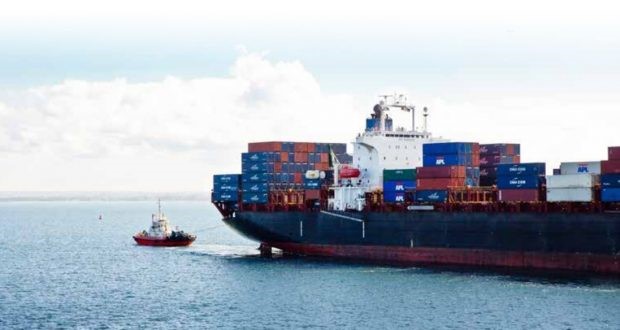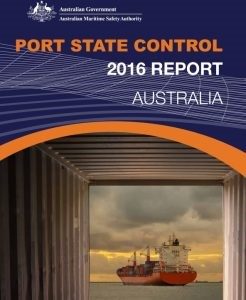
Australian Maritime Safety Authority (AMSA) issued its Annual Report on Port State Control for 2016, which summarises AMSA’s PSC activities and reports on the performance of commercial shipping companies. While there was an increase in the detention rate and rate of deficiencies per inspection, the overall picture indicates that PSC regime continued to exert a positive influence on the quality of shipping in 2016.
2016 at a glance
- During the calendar year there were:
-27,516 ship arrivals by 5719 foreign-flagged ships
-3675 PSC inspections
-246 ship detentions.
- Bulk carriers accounted for 51% of ship arrivals and 58% of PSC inspections.
- PSC inspections were carried out in 54 Australian ports.
- The average gross tonnage per visit was 50,505 GT compared to 48,011 GT in 2015.
- The average age of vessels in 2016 was nine years, compared to 10 in 2015.
- Surveyors conducted 8576 inspections of all types in 2016 compared to 10,536 in 2015. This decrease was through better targeting of higher risk ships.
In particular, AMSA informs that:
- The changes to the shipping industry’s regulatory framework by the Navigation Act 2012 and the adoption of the Maritime Labour Convention, 2006 (MLC) had their third full year in effect in 2016. This has enabled a maturing of the knowledge of the implementation of the MLC.
- In 2016, Australia’s response to ships and operators who performed poorly on a consistent basis resulted in the use of the directions power provided in section 246 of the Navigation Act 2012 to ban two ships from entering or using Australian ports for periods from 3-12 months.
- The PSC processes used for the MLC are now more established and it appears the understanding of what is expected with respect to compliance
has improved. This has resulted in a reduction in the total number of MLC deficiencies and deficiencies per inspection, in the period from 2014 to 2016. However, the ratio of detainable MLC deficiencies increased. - A number of detentions appeared to be related to the down turn in the global shipping industry leaving some ship owners and operators in financial difficulties. We understand this factor may present a challenge in maintaining the quality of ships visiting Australian ports. Such factors emphasise the need for maintenance of a firm, but fair, PSC inspection regime.
The following table presents comparison to previous year:

AMSA notes that, despite 2016 was the third full year after the implementation of the the Maritime Labour Convention (MLC) – an international convention developed by the International Labour Organization, that introduces modern standards relating to the living and working conditions of the world’s 1.5 million seafarers – the rate of deficiencies and percentage of total deficiencies remained quite steady.
However, the 2016 data demonstrates that the number of deficiencies for priority 1 and 2 vessels has decreased. Priority 4 vessels had a small increase in deficiencies per inspection rate. This trend further reinforces confidence in AMSA’s risk rating and inspection prioritisation systems, ensuring
resources are applied where they will have the most effect. Te inspections work with:
- Flag State control (FSC): Surveyors conduct inspections on Australian-flagged vessels subject to the Navigation Act 2012, using the same targeting arrangements applied to foreign-flagged shipping. AMSA conducted 82 FSC inspections on 66 Australian-flagged vessels during 2016, resulting in 222 deficiencies being recorded, of which one was serious enough to warrant detention of the vessel.
- Port State control – Australian-flagged ships (overseas) : Australian-flagged ships calling at foreign ports were subject to a total of 16 PSC inspections by foreign maritime authorities including New Zealand, the Russian Federation, Singapore, Papua New Guinea and Japan, resulting in 14 deficiencies and no detentions.
- Concentrated inspection campaign (CIC) : From 1 September 2015 to 30 November 2015, AMSA participated in a Concentrated Inspection
Campaign (CIC) on crew familiarisation for enclosed space entry. This was aimed at verifying compliance with the International Convention for the Safety of Life at Sea (SOLAS) and the ISM code and to ensure effective procedures and measures are in place to safeguard seafarers serving on board these ships. - Refusal of a ship’s access and condition of entry : Australia is a signatory to various International Maritime Organization (IMO) and International Labour Organization (ILO) Conventions which aim to ensure ships are safe. The Navigation Act 2012 provides additional powers that allow Authorities to consider issuing a direction, refusing access to Australian ports, where a vessel is a repeated offender, has a poor PSC record, or there are concerns about the performance of the vessel operator.
Further details may be found by reading the full report herebelow:

Source & Image credit: AMSA